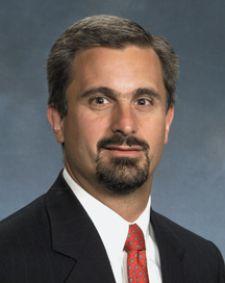
Jeff Collins, CEO and co-founder, Medipattern Corp., Toronto, Ontario, Canada
Asserting itself as a primary line of offense in the cancer treatment process, computer-aided detection (CAD) technology represents a significant step forward in helping clinicians pinpoint suspicious tissue.
Roughly a decade old, CAD emerged as a noteworthy cancer-detecting weapon courtesy of improvements in computer technology. CAD initially established its renown in breast applications because of its ability to detect cancer at an earlier point in screening. In addition, CAD manufacturers since have expanded the technology’s reach into chest, lung and colon applications to start. Some observers argued early on that CAD would revolutionize breast imaging to the point of supplanting traditional visualization techniques. Some have gone so far as to define the “D” in CAD as diagnosis, despite the fact that diagnosis and detection mean two different things, and suggested it could be substituted for more traditional visualization techniques. However, the hype eventually subsided so that CAD comfortably could be positioned as an effective “second read.”
Several performance-related challenges contributed to CAD’s position in the imaging and visualization segment of the cancer treatment process – particularly in the area of mammography. For example, CAD for mammo demonstrated an inability to find small masses under 1.5 mm, to identify and prevent architectural distortions and to reduce the rate of false positives.
Meanwhile, conflicting studies are catalyzing debate on CAD’s relevance and usefulness. For example, one key study showed that the use of CAD improves breast cancer detection and eliminates the need for double reading, versus another that argued double reading without CAD generates better, if not equivalent results.
Another challenge involves CAD’s overall cost. It’s quite pricey for smaller facilities, such as outpatient mammo centers and physician practices, particularly now that the federal Centers for Medicare and Medicaid Services (CMS) decided to decrease reimbursement for the procedure and the technology.
But are these challenges merely speed bumps or roadblocks in the development and progression of CAD, specifically among outpatient care facilities?
That’s what Outpatient Care Technology asked of the leading CAD manufacturers. In the first of a two-part series, these key executives told OPCT, by and large, that advances in computer technology and clinical techniques are reducing these speed bumps along the byway of healthcare delivery.
What do you foresee as the next big developments in CAD applications to expand functionality, improve performance and enhance patient care? Why do these additional capabilities and features make sense for outpatient care facilities?
Jeff Collins, CEO and co-founder, Medipattern Corp., Toronto, Ontario, Canada
Computer-aided detection will transition to support more of the diagnostic interpretation process. CAD applications will provide more services: better defining the reason why the feature should be noted, calculating the BI-RADS score and automatically generating reports. Physicians will be able to edit the reports before signoff, so that the diagnostic interpretation is the only documented report. As the patient load increases, and the volume of data from multiple diagnostic tests increases, physicians need to be able to focus in on the key information. CAD tools will help by organizing the data and presenting it in a standard method for interpretation and then since CAD is already highlighting and organizing, it is the next evolutionary step to follow through to generating reports. In fact, B-CAD for breast ultrasound already performs all of these steps — becoming a diagnostic aide — which is much more helpful than a detection aide.
Dave Faller, general manager, CAD Business, and Zhimin Huo, director of Clinical Programs, CAD Business, Kodak’s Health Group, Rochester, NY
While CAD is primarily used for cancer detection today, we believe it will be used in the future to help detect other conditions and/or diseases such as emphysema and osteoporosis. We also expect it to play an important role in screening for major diseases including cardiovascular disease and others. In terms of performance, we anticipate that future generations of CAD algorithms will be more sensitive and more specific, thereby enhancing patient care and simultaneously promoting an efficient workflow.
Outpatient care facilities will benefit from these enhancements since they will gain the ability to deliver CAD as part of new screening programs, and increasingly accurate CAD programs will help a limited radiology staff review a growing number of imaging procedures.
Alok Gupta, Ph.D., MBA, vice president, CAD and Knowledge Solutions, Siemens Medical Systems USA Inc., Malvern, PA
The use of computer-aided detection in diagnostic imaging is expanding rapidly beyond the established applications in mammography, chest X-ray, chest computed tomography and virtual colonography. In addition to all of the above mentioned categories, Siemens is developing new CAD applications in areas with high-volume imaging. Cardiac CAD, for example, enables automated detection and tracking of the endocardial border in echocardiography examinations to help clinicians provide robust measurements of cardiac ejection fraction. Siemens also focuses on expanding CAD from individual organs to whole-body imaging, being able to detect body regions and organs, thereby assisting the clinician with the diagnosis by detecting lesions within such organs. In addition, the temporal comparison of lesions across multiple studies is becoming increasingly relevant. Siemens has developed the syngo TrueD application that enables efficient reading of hybrid imaging studies from multiple sessions. Beyond detection, CAD tools will develop toward computer-aided classification to help improve the accuracy of the interpretation.
There are three types of challenges that need to be overcome in order to optimize the use of CAD in daily clinical care: (1.) algorithmic challenges, (2.) workflow challenges, and (3.) processing deployment challenges. Siemens is working with leading medical centers worldwide to build large databases to train and test CAD algorithms with the objective to increase sensitivity and reduce false positive detections. As far as workflow is concerned, Siemens’ focus is to fully integrate CAD into clinical applications so that detection and image analysis tools work hand-in-hand. The deployment of CAD is important to ensure that processing results are available when and where needed. For example, our innovative auto processing solution that is currently under development, recognizes unprocessed imaging studies that have been transferred to the workplace and then automatically applies the appropriate CAD algorithm in the background while the clinician can proceed with the current tasks.
In the long term, CAD applications will broaden along multiple dimensions, with the primary objectives of enabling personalized healthcare and improving efficiency and the quality of care. In addition to assistance in radiologic interpretation, CAD applications will evolve toward assisting clinical decision-making with actionable clinical knowledge at the point of care, with all relevant data, including images, clinical tests and patient history. Future CAD applications will provide support for all aspects of clinical decision-making for personalized patient management, such as diagnosis, test recommendations, prognosis, risk assessment and therapy recommendations.
The concept of knowledge-based clinical decision support will become a key enabler for evidence-based medicine. For this purpose, Siemens has developed the patented, award-winning REMIND platform (Reliable Extraction and Meaningful Inference from Nonstructured Data), which includes data extraction (e.g., natural language processing or proteomic analysis or image analysis), data combination and probabilistic inference. REMIND searches through the vast amounts of electronic healthcare data and information, including patient records with data in unstructured and structured format. The future is about being able to analyze all available information from patient records, and make inferences based on this information to help improve patient care.
Ken Ferry, president and CEO, iCAD Inc., Nashua, NH
First of all, we at iCAD are finding that CAD is particularly attractive as more centers are transitioning from film to digital mammography. With roughly 90 percent of digital mammography systems equipped with CAD capabilities, iCAD has become the standard of care in digital facilities.
Immediate developments in CAD for conventional 2-D mammography focus on performance improvements, usability enhancements and IT integration enrichment. At iCAD, our goal is to improve cancer sensitivity while lowering false positive rates and to provide additional clinically relevant information to radiologists in an easy to use format. These developments will increase the confidence radiologists have for CAD marks and enable them to use iCAD solutions efficiently with all leading PACS and review workstations.
Beyond traditional mammography, we believe CAD for tomosynthesis will be the next big development in mammography, providing increased clinical benefit for radiologists. iCAD is developing tomosynthesis CAD solutions that help radiologists better detect cancer and analyze the large amount of data generated by the 3-D imaging.
Mammography CAD makes sense for outpatient care facilities because these facilities may not have dedicated specialists in mammography reading, so improving CAD performance can help enhance screening in these settings, while providing a marketing opportunity for the center.
Outside of mammography, we’re applying iCAD’s patented detection technology and algorithm platform to other disease states where pattern recognition, artificial intelligence and image processing will play a pivotal role in early cancer detection. There is a lot of work going on to establish the benefits of CAD with colon, chest and lung screenings, and in ultrasound, CT and MR. There is potential to continue to enhance the raw performance of the CAD technology with these applications.
Julian Marshall, director, Product Management – CAD, Hologic Inc., Bedford, MA
CAD is widely accepted in breast imaging. To a certain extent, reimbursement is driving the adoption of digital mammography. Last year, when Medicare was making some across-the-board cuts in all medical technologies; mammography emerged unscathed in the new rates that the CMS introduced for January 2007. CAD reimbursement was dropped slightly for 2007.
For CAD, the Medicare reimbursement for the technical component dropped from $19.71 to $17.43. The professional component remained unchanged at $3.41. Reimbursement is helping digital mammography with CAD. Analog mammography is reimbursed at $85 per mammogram and digital mammography at $135. That increase is enabling facilities to afford the equipment.
There are centers that scan 45-50 patients a day per machine in a screening environment where workflow has been optimized. Reading has also been optimized, and as a result, it doesn’t take long to pay off even a digital mammography product.
The new frontier in breast imaging is workflow, and we’ve devoted a significant share of our R & D and engineering resources to integrating CAD with digital mammography acquisition and visualization systems to streamline patient care, improve outcomes, and lower imaging center costs. At RSNA [2006] we demonstrated how our Citra mammography applications suite might work on our SecurView workstation and we’re driving to bring that product to market. Citra is the first commercial product to demonstrate that CAD and a single human reader exceed the performance of two human readers in detecting cancers. The first referred paper supporting the use of Citra tools on a breast imaging workstation was published in Radiology in 2006. (Gilbert FJ, Astley SM, McGee MA, Gillan MGC, Boggis CRM, Griffiths PM and Duffy SW. “Single reading with computer-aided detection and double reading of screening mammograms in the United Kingdom National Breast Screening Program.” Radiology 2006; 241: 47-53)
Beyond the breast, chest, lung and colon, which additional areas of the anatomy make the most sense for CAD to reach and why?
COLLINS: CAD provides its best value in applying standard rules to look at images with its impartial computer eyes and organizing data. Unlike the modalities, which enable physicians to look inside a multitude of patient conditions, CAD has to learn the rules to identify each disease – one disease at a time. Therefore, CAD will be focused on the world’s top threats and of these threats the only two that have not seen the benefit of CAD yet are prostate cancer and heart disease. These two would be the next steps.
FALLER & HUO: CAD programs for detection of prostate cancer are in development, and we foresee the increased use of CAD as a screening tool for a number of common diseases, such as cardiovascular disease. CAD is particularly helpful in detecting abnormalities in screening applications where radiologists are viewing a high volume of very repetitive, and predominantly normal, exams.
FERRY: We are always looking to apply our CAD algorithms in areas where there are established or emerging minimally or noninvasive screening protocols that can have a significant impact on outcomes and where early, effective detection provides a strong clinical benefit. In addition to breast, chest, colon and lung, we see an opportunity for CAD with cardiovascular disease, as it is a particularly devastating condition affecting a significantly large number of people. CAD has an opportunity to help in the early detection of coronary artery and peripheral vascular diseases. However, iCAD’s top priority continues to be improving CAD performance for our existing disease states and modalities.
MARSHALL: Due to the overwhelming and ever increasing amount of data we believe that CAD will eventually be pervasive across most modalities and disease states.







 June 06, 2023
June 06, 2023 









